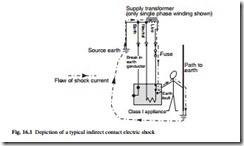Principles of electrical safety
Injuries from electricity
Every year people are injured or killed as a result of hazardous defects in electrical systems or because they adopt unsafe working practices on electrical systems. The most common types of injury are electric shock and burns, with the burn injuries arising from either current passing through the body or from the effects of arcing and flashovers. In addition to these direct forms of electrical injury, the following secondary types of injury can occur:
● burn injuries and the adverse effects of smoke or fume inhalation from fire of electrical origin
● the effects of an explosion that has an electrical source of ignition
● physical injuries arising from the reaction to electric shock, such as being thrown off a ladder as a result of electric shock and suffering impact injuries from the fall
Electric shock
Electric current passing through the body, particularly alternating current at power frequencies of 50 Hz and 60 Hz, may disrupt the nervous system, causing muscular reaction and the painful sensation of electric shock. The most common reaction is to be thrown off the conductor as a result of the muscular contraction. However, in a small number of instances, the consequence is death from cardiac arrest, or from ventricular fibrillation (where the heart muscle beats in a spasmodic and irregular fashion) or from respiratory arrest.
The physiological effects are largely determined by the magnitude and frequency of the current, the waveform (for example, continuous sine wave, or half wave rectified sine wave, or pulsed waveform), its duration, and the path it takes through the body. An authoritative guide on the topic is published in IEC 60479 (see Table 16.2). The following text concentrates on the most common situation of a shock from a continuous power frequency ac waveform.
The magnitude of the current is the applied voltage divided by the impedance of the body. The overall circuit impedance will comprise the body of the casualty and the other components in the shock circuit, including that of the power source and the interconnecting cables. For this reason, the voltage applied to the body, which is commonly known as the touch voltage, will often be lower than the source voltage.
The impedance of the body is determined by the magnitude of the touch voltage (there being an inverse relationship between impedance and voltage) and other factors, such as the wetness of the skin, the cross-sectional area of contact with the conductors, and whether or not the skin is broken or penetrated by the conductors. As a general rule of thumb, at an applied voltage of 230 V at 50 Hz, the total body impedance for a hand-to-feet path will be in the range 1000 Ω to 2500 Ω for most of the population, falling to around 750 Ω at voltages in excess of about 1000 V.
The path that the current takes through the body has a significant effect on the impedance. For example, the impedance for a hand-to-chest path is in the order of 50 per cent of the impedance for a hand-to-foot path. Moreover, the current’s path through the body is a significant determinant of the effect on the heart.
Table 16.1 summarizes the physiological effects of current passing through the body. The effects relate to a hand-to-hand shock exceeding 1 s for a person in good health. If the duration were less than 1 s, greater currents could be tolerated without such adverse reactions.
Electric shock accidents are most common on low-voltage systems and are usually subdivided into two categories of direct contact and indirect contact shocks. A direct contact shock occurs when conductors that are meant to be live, such as bare wires or terminals, are touched. An indirect contact shock occurs when an exposed conductive part that has become live under fault conditions is touched, as depicted in Fig. 16.1. Examples of an exposed conductive part are the metal casing of a washing machine and the metal casing of switchgear. This type of accident, which requires two faults to occur (the loss of the earth connection followed by a phase-to-earth fault), is quite common.
When providing first aid to an electric shock casualty, the first action should be to remove the cause by switching-off the supply or otherwise breaking contact between the casualty and the live conductor. Cardiopulmonary resuscitation may be required. If the casualty is suffering from ventricular fibrillation, the only effective way to restore normal heart rhythm is by the use of a defibrillator. Where a defibrillator is not immediately available, the first aider should carry out cardiopulmonary resuscitation until either the casualty recovers or professional assistance arrives.
Contact and internal burns
In addition to causing electric shock, current flowing through the body may cause burn injuries at the points of contact and in the muscle and other internal tissues and organs.
The extent of any burn injuries is determined by the current density at the point of contact and in the internal tissues; the higher the current density the more severe will be the injuries. The magnitude of the current will be determined by the same factors as described in section 16.1.1.
It is uncommon to see significant burn injuries when the touch voltage is low, including mains voltage of 230 V ac. The usual physical evidence is small white blister-like marks on the skin on the entry and exit points but there have been accidents where more severe burns have been experienced. At higher voltages, especially in incidents involving contact with an overhead high-voltage power line, the burning is invariably severe and can be the main cause of death.

